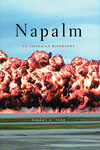
Napalm: An American Biography, by Robert M. Neer, Belknap Press, Cambridge, Mass., 2013, $29.95
Early World War II incendiary bombs burned hot but not for long. Flamethrowers using hydrocarbon liquids suffered the same problem. A team of Harvard chemists led by Louis Fieser invented a solution in 1942: a dry powder that when mixed with gasoline was highly flammable and sticky. The name of the resulting weapon, napalm, was derived from naphthenic acid and palmitic acid.
Napalm retains the grisly reputation it acquired 50 years ago, and author Neer—a lecturer in history at Columbia University—does an admirable job of describing its career as the archetype of inhumane weapons.
Although first used in Europe in 1944, napalm bombs quickly proved ideal in the Pacific against deeply dug-in Japanese troops and were the mainstay of the massive incendiary attacks on Japanese cities. During the Korean War, American planes dropped napalm on both enemy troops and North Korean cities. After the war researchers developed an improved version, napalm B, a mixture of benzene, gasoline and polystyrene that burned for up to 10 minutes, compared to 30 seconds for the original formula. It was also safer to handle.
Burning napalm sticks to human skin and can’t be easily removed or extinguished. Few complained of its use when the victims were enemy soldiers. But its uses in Vietnam produced ghastly—and widely publicized—civilian injuries.
Antiwar protestors’ denunciation of napalm persuaded most American manufacturers to get out of the business. Dow Chemical persisted, but its public image suffered. Not until 2009 did the United States sign a 1980 United Nations convention forbidding the targeting of civilians with incendiary weapons, and an addendum to the convention still allows for their use under certain conditions.
—Mike Oppenheim




